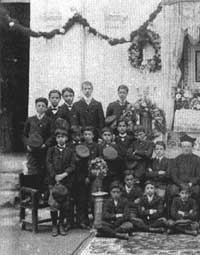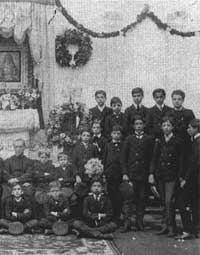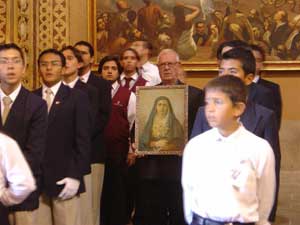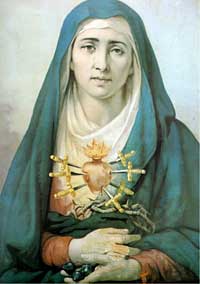|
Newsletter of the District
of Asia
July
- December 2006
Our
Lady of Quito
Queen of Ecuador
1906
– 2006
(First English translation, by Fr. Paul Kimball SSPX, of
La Dolorosa
de Quito, Reina del Ecuador,
with authorization of the publisher, Libreria Espiritual, Quito)
Part 1
We are going to relate a prodigious event that occurred on April
20th, 1906 in the capital of Ecuador, and which the ecclesiastical
authorities, after meticulous examination, declared to be a miracle.
But before, for a better understanding of this, we recall the historical
circumstances.
Ecuador
was the first nation that officially consecrated itself to the Sacred
Heart of Jesus on March 25, 1874 and on August 6, 1892 to the Immaculate
Heart of Mary.
In the solemn consecration of 1874, read by the very important representative
of the Church, Archbishop Checa y Barba, and afterwards by the president
of the nation, García Moreno, was sealed an irrevocable pact:
“Prostrate before your divine presence, all the public powers
of the Church and of the State offer and consecrate to Thee now
and for always the republic of Ecuador as Thy exclusive possession
and property.”1
The pact was sealed with
the blood of the president, assassinated on August 6, 1875, the
First Friday, in the same church of the consecration and the same
day on which he had noted in his spiritual diary: “Lord Jesus,
show me what it is that I ought to do today for Thy love.”
Also in the same church, on Good Friday of 1877 the Archbishop was
poisoned to death.
At the death of Garcia Moreno a moderate liberal, Antonio Borrero,
was elected, but General Veintimilla, an extreme liberal, who was
defeated in 1883, rebelled. There was a moderately lawful era until
1895. Then, an extreme liberal,
General Eloy Alfaro rebelled, and remained in power for twenty years
taking part in revolutions. He was a dictator from 1895 to 1901
and from 1906 to 1911 thanks to another revolution. Finally he returned
to rebel against his successor in 1911, but was defeated and lynched
in 1912. General Leónidas Plaza, a companion of the former,
governed from 1901 to 1905, and returned to power in 1912-1916 by
another rebellion… and so the countless rebellions continued.
 
The
forty boys who were the witnesses
of the movement of the eyes in the picture of Our Lady of Quito,
with the Father Prefect (or head of discipline), Andrew Roesch,
and Brother Assistant Supervisor, Louis Alberdi.
Seated next to the priest and brother are three eleven year old
boys,
who on Holy Thursday of the previous week had made their First Communion:
James Chávez, Charles Herrman, and Peter Donoso
and were the first ones to notice the prodigy.
In 1895 General Alfaro “a model of infamy” promised
Pope Leo XIII to maintain harmony with the Vatican, but in the following
year he broke the Concordat. He expelled the Jesuits from the Amazon
region, where they had founded 152 villages. He forbade the establishment
of new religious congregations in the country.
In 1900 the Ecuadorian Congress decreed the secularization of convents.
It restricted the freedom of teaching, and the colleges were unable
to give examinations. In the state schools it suppressed the teaching
of religion. It revoked the decree of the National Consecration
to the Sacred Heart.
In 1901 the government seized part of Saint Gabriel’s College
from the Jesuits. The following year General Plaza established civil
marriage and divorce. In 1904 he forbade novitiates, and deprived
the religious institutions of their goods, the slogan being: “Independence
from Spain, independence from Rome.”2
In 1906, Alfaro reached the point of a complete rupture with the
Church. He forbade Bishop Riera, the consecrated bishop of Portoviejo,
to enter
into his diocese. The constant persecution forced the number of
students in Saint Gabriel’s College to be reduced from 400
to 150. Not content with this, a decree was already prepared, to
expel the Jesuits from the college they were operating since 1862,
and it was one of the few Catholic colleges that remained. (It is
the usual hellish technique: the best way to de-Christianize a country
is to prevent its youth from receiving a Catholic education and
formation).
Intervention of the Virgin
The Virgin chose the same college dedicated to one of the Archangels:
Saint Gabriel.
The place was the dining hall of the boarding students, 72 feet
(lessened by a partition to 43 feet) by 23 feet, on the first floor
of the college.
The picture, a color oleograph3 (20 inches long by 16 inches wide)
of the Sorrowful Heart of Mary (Our Lady of Sorrows with her heart
pieced with seven swords), printed in France. The Jesuits had purchased
three of these from a traveling salesman, and one of them was placed
in the dining hall, on the right side as one enters, six feet from
the floor. Between it and the floor was a bench 16 inches high.
The picture was one of the many pictures in the college.

The
miraculous picture is escorted by the present student of the College
of St. Gabriel
to be solemnly placed above the main altar of the Compañia,
the Jesuit church adjacent to the old College of St. Gabriel where
the miracle took place,
after having been brought throughout all Ecuador with a procession
in each city.
The time: 8 o’clock at night on April 20th, 1906, Easter Friday.
The persons: 35 boarding students, aged between 11 and 17 years
old, coming from every region of Ecuador: the Father Prefect (or
head of discipline), Andrew Roesch, a Frenchman; the Brother Assistant
Supervisor, Louis Alberdi, a Spaniard; and three employees. (The
rector of the College was Father Andrew Machado of Cuenca, Ecuador,
who would later become the bishop of Guayaquil).
Because it was the Easter vacation, the students had returned that
day tired from an excursion. After a short period of study, they
were brought to the two large tables of the dining hall that ran
parallel to the side walls, for supper. Near the end of the meal
the Father Prefect arrived and gave the “Deo gratias”
(permission to speak, in place of listening to a reading), and told
them the news of the terrible earthquake that had occurred on the
18th of the month in San Francisco, California. The students of
the College were very familiar with this type of tragedy, as earthquakes
are not uncommon in Ecuador.
The children were chatting with one another. In front of the picture
of Our Lady of Quito there were three eleven year old boys, who
on Holy Thursday of the previous week had made their First Communion:
James Chávez, Charles Herrman, and Peter Donoso. Struck by
the news of the devastation in California, Chavéz was saying
that he would like to die in an earthquake, after receiving Holy
Communion. Father Prefect called Donoso to his table. Herrman remained
with Chavéz, who was looking at the Virgin, when… But
let us ask him himself what happened next.
“We finished taking coffee, the Brother Alberdi came and told
us about the earthquake in California and we began to speak about
the Virgin. I said that the seven swords were driven in by our sins;
and I looked at her, and she was moving her eyelids; and I thought
that it was my imagination. The other boy looked afterwards and
said to me, ‘Look at the Virgin,’ and we kept looking.
“Seeing what was happening we knelt down; we prayed an Our
Father and a Hail Mary. We were looking at what was happening; I
called Peter Donoso saying: ‘Come and you will see this funny
thing.’ I called him three times. She [the Virgin] was moving
her eyes, the left one and afterwards the right one; the first time
she was moving them a little more quickly. After a repetition of
two or three times she was closing both.” This was the response
of elevenyear- old Charles Herrman, in the canonical process. Let
us also read that of his companion, Chávez:
“When we finished eating we said, Deo gratias, and
we were speaking about the Virgin and the Father Prefect called
one of the boys to the other table, and two of us remained alone.
And then I looked upwards, and I saw that the eyes of the Virgin
were beginning to tremble like someone who is in agony, and seeing
this I said to the other boy, ‘Let us pray an Our Father and
a Hail Mary,’ and we knelt down. Then we sat down again. And
looking at what was happening, we informed the others and some of
them came. Then we went to get the Father Prefect, but he did not
want to come. Afterwards we went to get him again and he came, but
he did not want to believe at all. And Brother Alberdi stood in
the middle and said, “It is certain,” but he [the Father
Prefect] still did not want to believe, until all the boys were
repeating at the same time: ‘Now she opens, now she closes!’
After a quarter of an hour the bell rang for us to go to the chapel
before the incident ceased.”
And so it began. In fact, Donoso who was in the group of the Father
Prefect, when his friend Hermann came running to get him, paid no
attention to him. The other boy had to invite him three times before
he would get up and go: “I went over,” Donoso relates,
“and I saw the eyes of the Virgin moving; and I covered my
eyes so as not to see, out of fear, and I went another time where
Father Roesch…”
Naturally, the priest did not at all believe that the Virgin was
moving her eyes; nor did he change his mind. How was he going to
believe this sort of thing from boys? Brother Alberdi declared in
the process, “One of the boys of the first tables came to
tell us that the Virgin was moving her eyes; and we went closer
coldly and with little enthusiasm, as least speaking for myself.”
Likewise the other boys were stubborn in not believing or going
closer, and they delayed for about a quarter of an hour. Many did
this, as they later declared: “Although we did not believe,
and we continued our conversation, since everyone was getting up
we went to see out of curiosity.” Another testified: “Upon
receiving the news it made no impression upon me, and I even laughed,
but curiosity got the best of me and I got closer to the Virgin.”
And another relates: “When we heard it said that the Virgin
was opening and closing her eyes, we went with the intention of
making a joke out of what they were saying. Almost all of us did
not care about it. I went, but to make fun, and while shoving the
others who were coming with me.”
The Prefect, Father Roesch, declared in his turn: “With great
insistence another boy came to urge me to go to see what was happening.
At first I refused what they asked saying that he should stop the
nonsense, because it seemed to me to be an illusion of the boys;
but finally, because of the urging and the calling by all those
who were witnessing the prodigy, I went over to the table that was
located closest to the picture, with the resolution formed of dispelling
the notion. I verified with much determination that the electric
lights were not moving, or if some beam was reflecting on the image;
none of this appeared.
“Standing in front of the image surrounded by the children,
I fixed my eyes on her, without blinking, and I observed that the
Most Holy Virgin was slowly closing her eyes; but still not believing
that I was certain, I left the place. The Brother, who was more
certain than I, seeing this, said to me, amazed at what was happening,
“But Father, what if this is a miracle? What if this is a
miracle…” I returned again to the spot where I previously
was; then I felt a coldness that chilled my body, while seeing,
without any possible doubt, that the picture was actually closing
and opening its eyes. When this was happening all the children that
were watching the prodigy were crying out with one voice, ‘Now
she closes; now she opens; now the left.’ But it should be
noted that at times she was closing only the left eye or at least
more clearly than the right, since it appeared to be more closed.
The prodigy repeated itself several times and lasted a little more
or less than fifteen minutes. It ceased when, seeing that it was
already very late for the night prayers, and always fearing to give
too much attention, I gave the signal for the students to retire;
which they did very much to their regret, since they wanted to kneel
and pray. I forbade any noise that would cause a disturbance, since
it seemed to me that if the prodigy was miraculous the witnesses
would not be lacking to prove it. At first I believed it to be an
illusion, and afterwards I was seen going away still without giving
credit. Urged again by the Brother, I returned, and the blinking
was so evident to me, that it gave me the feeling of a chill, and
I remain in this conviction.”
As can be seen, they all were incredulous at the beginning. The
first one who said that he saw the miracle, Charles Hermann, did
not believe his eyes, for which reason neither did he make any comment
to his companion, James Chávez. The latter was the first
that told someone else about it.
Father Roesch not only was incredulous, he feared being influenced
by the extraordinary and, incomprehensibly—it proves his objectivity—,
he gave the signal to go to the chapel to pray the rosary when the
Virgin was continuing to open and close her eyes. And when Brother
Herman Alberdi suggested to him: “Let us take the picture
of the Virgin to the chapel so that we can pray the rosary in front
of her,” he did not consent. Likewise he neither permitted
a boy, determined to inform the Father Rector, to do it. Even more,
he told the students not to say anything to anyone.
Nevertheless, as soon as they left the dining hall, immediately
the news spread throughout the house. Some priests did not refrain
from coming to the dining hall, but nothing extraordinary happened.
The picture of the Sorrowful Virgin, with her heart transpierced,
had the same eyes as always. The phenomenon had ceased, or had it
really?
1.Cf.
the famous indulgenced prayer written by Father Nicola Zucchi S.J.
(†1670): “My Queen! My Mother! I give thee all myself,
and, to show my devotion to thee, I consecrate to thee my eyes,
my ears, my mouth, my heart, my entire self. Wherefore, O loving
Mother, as I am thine own, keep me, defend me, as thy property
and possession. Amen.”
These
words would be later incorporated into the Prayer of Total Consecration
by St. Maximilian Kolbe: “O Immaculata, Queen of Heaven and
earth, refuge of sinners and our most loving Mother, God has willed
to entrust the entire order of mercy to thee. I, N___, a repentant
sinner, cast myself at thy feet humbly imploring thee to take me
with all that I am and have, wholly to thyself as thy possession
and property. Please make of me, of all my powers of soul
and body, of my whole life, death and eternity, whatever most pleases
thee. If it pleases thee, use all that I am and have without reserve,
wholly to accomplish what was said of thee: ‘She will crush
your head,’ and, ‘Thou alone have destroyed all heresies
in the whole world.’
“Let
me be a fit instrument in thine Immaculate and merciful hands for
introducing and increasing the maximum in all the many strayed and
indifferent souls, and thus help extend as far as possible the blessed
Kingdom of the most Sacred Heart of Jesus. For wherever thou enters,
one obtains the grace of conversion and growth in holiness, since
it is through thy hands that all graces come to us from the most
Sacred Heart of Jesus.”
2.
It is a key phrase for understanding the hidden conspiracies that
direct history. The attack on the Church, Christ’s kingdom,
an attack directed without ceasing by the prince of this world (“the
two standards,” following St. Ignatius, in the perpetual battle),
has reached in the last centuries the main political powers that
favored the Church: the Spanish empire, the Austrian-Hungarian empire
(World War I), the French and the Portuguese colonial empire (World
War II)… —thus dealing a hard blow to the Catholic missions.
The consequences have been terrible.
Which are the hidden hands? Today it will be above all the KGB,
the Russian antichrist, which finances — without money it
would be impossible— the terrorist movements and many pro-independence
movements, by getting a fifth column of traitors in every country:
resentful, ambitious, naïve (not without any benefit)…
Since the 18th century Masonry (in its various branches) also introduced
itself into Spain on this side and on the other side of the ocean,
and was the great motivator of liberal anti-religious “change,”
about which these same men are vainglorious and for any reason they
denounced the Popes and Catholic historians. (There are many enlightening
facts, e. g. the letters of Napoleon to the lodges of North America
so that they stir up rebellion in the Spanish lands overseas, by
exaggerating the defects of the unitary government, defects which
will always be had, but whose remedy is worse than the sickness,
inasmuch as the present day economic and religious sluggishness
proves that united countries were the most advanced. Why will one
not study history more?
Of course the takeover of power in our countries by anti-christian
governments, and the consequent national decadence, is a punishment
for sins. The thesis is insupportable (e. g. of Aranguren) that
countries by being Catholic are more underdeveloped than Protestant
countries, as if God treats His better children worse. Nor is it
admissible, for the same reason, the “martyr” theory:
namely that Spain bleed itself through defending Catholicism against
the Protestants; it bled itself more in the Reconquest, and its
fight for the Cross had as its reward an empire.
It is necessary to loudly proclaim these truths and historical criterions,
in order to wake up sleeping consciences without any ideals. To
eliminate the infuriating scandal that Catholic countries have submitted
to anti-Catholic laws in education, the family, and worship…
by a minority: that says it is defending liberty. The situation
has to change, and we hope soon, when the promise of Fatima has
been accomplished: “In the end my Immaculate Heart will triumph”
and “Thy kingdom come” will be accomplished, with the
conversion of Russia and the reunification of the Spanish peoples
under Christ (“I will reign in Spain”), as a condition
for carrying out our evangelical world-wide mission, to which we
are called by the unmerited grace and divine predilection, through
the mediation of Holy Mary.
3.
An oleograph is a lithograph printed in oil colors to imitate an
oil painting.
contents
|


![]()
![]()



